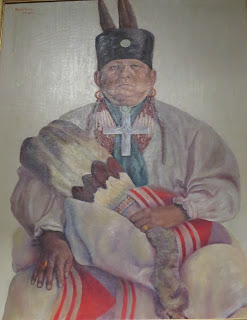Just a few of the beautiful paintings, by various artist, deplicting Indian Chiefs. And some a brief history.
Chief Yellow Shield
After a major defeat, he realized the futility of opposing the government troops.
He became a scout for the troops, and remained loyal to the government the rest of his life.
painted in 1836 when he was 86
Chief Chatto-Chiricahua Apache
Chato was a great Mountain Apache chief and warrior who led raiding-parties along with Apache Chiefs Boniot, Victorio, and Geronimo, killing settlers in New Mexico, Arizona, and Mexican territories. After surrendering he became an army scout, received a presidential medal, and settled on the Mescalero Apache Reservation in Ruidoso, New Mexico. He was killed in an auto accident in 1934
Geronimo
His native name was Goyathlay (One Who Yawns). Geronimo was nickname given him by Mexicans. Born about 1874, Geronimo was a prophet and warrior of the Chiricahua Apache.
Looks on the Ground-Crow
This tribe was called"Apsaalooke," which means "children of the large-beaked bird." White men later misinterpreted the word as "crow."
Big Chief
Sequoyah
c (1770-1840), was a Cherokee silversmith. In 1821 he completed his independent creation of a Cherokee syllabary, making reading and writing in Cherokee possible.
Chief Two Guns Whitecalf
He was born near Fort Benton, Montana, son of White Calf who was known as the last chief of the Pikuni Blackfoot. Later in life, he became a fixture at Glacier National Park. When he first saw the buffalo/Indian-head nickel (released in 1913) he was convinced that it was his own likeness on the coin.
Chief White Eagle-Ponca
He was the hereditary chief of the Poncas when they came to Indian Territory in 1877. As chief, he led the Poncas in their last war against the Sioux before they left Dakota Territory and Nebraska. He was also the medicine man and religious advisor. White Eagle led the "hot country" Poncas, they remained in Indian Territory for 50 years.
Wiki
He was one of the old Snake Priests of the Antelope Clan at Walpi, Arizona. The Snake Dance, in which live snakes are carried, is celebrated principally as a prayer for rain.
Chief Pawnee-No-Pashe - Osage
Quanah Parker
A Comanche warrior and political leader who served as the last official principal chief of his tribe. Hew was the son of Peta Nocona, a Comanche chief, and his wife Cynthia Ann Parker, who had originally been a white captive of the Comanches.
Black Kettle
Although Southern Cheyenne chief Black Kettle was an advocate for peace with the white man his camp was destroyed November 27, 1868 by forces led by George Armstrong Custer.
On the Washita, the Cheyenne hope of peace and independence died along with their people. Black Kettle the man, the Indian chief, the advocate of peace, died at the hands of those he trusted, sought peace with, and believed in.
Weasel Tail
born and raised among the Blood Indians in Canada, but spent most of his adult life among the Piegans south of the border. In his youth he had hunted buffalo and had been on a number of horse stealing raids against neighboring tribes. His memory of the details of Blackfoot life in those days was remarkable. As a young man he had repeatedly questioned some of the oldest men and women of his tribe about the life of the Blackfeet in earlier times.
Julia Lookout-Osage
She is the wife of Chief Fred Lookout of the Osage Nation.
The Lookouts were great friends of Frank and Jane Phillips.
Chief Fred Lookout - Osage
Chief Bacon Rind - Osage
Wah-she-hah was called Bacon Rind, but the real translation of his Osage name was Star-That-Travels. He was born in Kansas a decade before the Osage tribe bought their reservation in northeast Oklahoma. He was superb politician and recognized early on the value of the enormous oil reserves that lay beneath their rocky reservation.
Chief Marrow Bones- Blackfoot
Medicine man; spiritual and political advisor with a character of great beauty. Broad minded and progressive and worked hard with his people for advancement. Worked with the Government to get the Indians to raise good stock instead of scrub.
General Custer
George Armstrong Custer was born on December 5, 1839, in New Rumley, Ohio. He served in the Civil War with General George B. McClellan. He became a brigadier general, and his pursuit of General Rober E. Lee helped to bring an end to the Civil War. In September 1868 he joined the 7th Cavalry in Kansas. On June 25, 1876, he led 210 men into battle at Little Bighorn against Lakota and Cheyenne warriors. Custer and all his men were killed in the battle.
Sitting Bull - Lakota
c(1831-1890) he was a Hunkpapa Lakota holy man who led his people as a tribal chief during years of resistance to United States government policies. Before the Battle of Little Bighorn, Sitting Bull had a vision in which he saw the defeat of the 7th Cavalry under Lt. Col. George Armstrong Custer on June 25, 1876. Sitting Bull's leadership motivated his people to a major victory. He was killed by Indian agency police on the Standing Rock Indian Reservation during an attempt to arrest him.
Chief Bull Child -Blackfoot
Their great medicine man of the 1890s and early 1900s. A man of impressive dignity, beautiful religious character and great knowledge of nature, and reverent confidence of his people.
Chief Spotted Elk - Sioux
Leader of the swift band in Custer's battles. Several times on diplomatic trips to Washington. A strong and typical Sioux face and character.
Medal on neck given him by General Grant when President.
Crow Chief
Na-Tu-Ya (Blessed) - Blackfoot























No comments:
Post a Comment